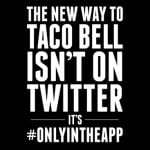
With websites and social platforms now at the center of marketing communications, one of the best practices for building these channels is to make sure they are “well-lit,” where consumers can feel comfortable familiarizing themselves with brands and organizations and have little trouble navigating from one destination to the next. However, Taco Bell took that practice and turned it on its head late last month—at least for a while—and, in the process, cut through the clutter.
On October 29 the fast-food chain “blacked out” its website, as well as its Facebook, Tumblr and Twitter pages, and replaced the channels with a single post promoting a new mobile payment app.
Call it disruptive or innovative—in the context of digital PR, the terms are relatively synonymous these days. Either way, the Taco Bell “blackout” serves as a compelling reminder that, as online communications become commoditized, PR pros are on the hook to create unusual campaigns that grab the attention of consumers and the media alike.
Taco Bell’s PR effort produced ample media coverage, ranging from USA Today to several PR, marketing and advertising publications.
The campaign also generated more than 1 billion media impressions. Perhaps most important, just 24 hours after the launch, Taco Bell said that 75 percent of its 6,000 stores already had processed a mobile order.
To extend the campaign, which lasted three days, Taco Bell augmented its blackout with Promoted tweets, social ads on Facebook and 30-second TV spots. For the duration of the campaign, Taco Bell limited the amount of content on its social platforms to keep the focus on the new app.
Each of the company’s social media platforms, as well as tacobell.com, provided a link to download the new app.
“We see mobile apps as biggest thing in our industry since the drive-thru,” said Rob Poetsch, director of communications at Taco Bell. “We think this is the way for us to unlock our kitchen and create an experience that is really unprecedented when it comes to customization.” About 70 percent of Taco Bell’s orders are customized.
Taco Bell’s original idea was to “black out” all the menus in its restaurants and replace them with an image promoting the new app. But that presented operational challenges.
“We realized that the best experience and the best way to convey the message was through social and digital channels,” Poetsch said. “We wanted to jar and jolt people, but also provide several ways that we could casually direct them to the app.”
He added that the campaign was rooted in “social listening,” which more and more brands have started to embrace.
“If you never do, you’ll never know and we take that very seriously,” Poetsch said, referring to the unorthodox approach of Taco Bell’s campaign. “What you’ve never done creates a lot of excitement, but it needs to be authentic to the brand. It’s all about listening.”
Lisa Astor, VP of PAN Communications, said the Taco Bell blackout campaign marks the continuing evolution of social media.
First, she said, companies had to simply populate their social channels; second, they had to engage their customers and prospects via social media; now, brands need to disrupt their social platforms or face diminishing returns.
“It’s a matter of shaking things up and not doing what’s expected of you,” she said. “At some point social media is going to get overloaded and will become passé. Companies are going to have to figure out what Taco Bell did and try and create that opportunity in their own way—not necessarily by copying it.”
The Taco Bell campaign was distributed in a “way that made people feel that they were automatically ‘in the know,’” Astor said. “They were then able to direct people to the new app and monetize users. But it’s getting harder to make that conversion.”
Another way to distinguish the brand from the pack is to play into people’s skepticism about a product or service—and demonstrate why that skepticism is unfounded.
To wit, for the last several months Thermos LLC has been periodically running a contest on its Facebook page to promote its vacuum-insulated 40-ounce Stainless King beverage bottle. Baristas throughout the country grind and brew up fresh, hot coffee, pour it into the bottle and overnight it by plane across the country, where it’s delivered to contest winners, still hot and steamy up to 24 hours later.
Through three separate rounds of the Overnight Coffee Challenge, there have been roughly 10,000 contest entries, while 91 bottles have been shipped to 64 cities throughout the country.
“It’s been fun to see how people react,” said Courtney Fehrenbacher, associate marketing manager at Genuine Thermos Brand.“A lot of people didn’t believe we could really get it to them overnight because they lived in remote locations. So when it showed up hot at their doorstep, they shared their excitement with us through social and emails.”
5 Ways to Disrupt Your Brand’s Digital and Social Presence
As more brands flock online, consumers are skeptical of marketing messages, forcing companies to take a disruptive approach. Here are my top tips to being a disruptive digital marketer.
▶ Innovate every day. Innovation is at the core of any disruptive marketing strategy. The beauty of a digital community is that you are sitting on top of all this rich data, providing valuable customer insights. What do they care about? What motivates them to share? Why do they enjoy your product? What is the lifestyle they live? What technology do they use? Leveraging this information and bringing it into planning sessions to innovate and create new programs is a must.
▶ Be patient. Good ideas take time to cultivate. Every great idea is born from hundreds of bad ideas. You can’t stop ideating. Create an open brainstorm culture, in which everyone from the intern to the developer to the VP of marketing can toss in an idea and be heard. You never know where your next big idea will come from.
▶ Think big and think bold. Start with big thinking. Be fearless to mention the far-fetched if it’s intriguing and aligned with the strategy. It is easy to scale down, but the worst thing you can do is stifle your thinking. In today’s market, you have to be different, and being different requires you doing something that catches attention and breaks the mold. If an idea feels uncomfortable or you feel afraid, that’s a good sign that you have something original.
▶ Failure is a possibility. There are no guarantees in disruptive marketing. You can use research and insights to support ideas and you can calculate risk, but nothing is certain. Testing and learning is at the heart of a disruptive mindset.
▶ Engage multiple stakeholders. The ideas out there that create sensation are seldom a one-team act. Execution requires buy-in from other stakeholders; the earlier you can bring them in the development of the idea the more excitement you will generate. If everyone can own the idea together you know everyone is driving toward a successful program collectively.

This sidebar was written by Sahana Jayaraman, head of digital and content marketing at Eastwick. She can be reached at [email protected].
CONTACT:
Lisa Astor, [email protected]; Courtney Fehrenbacher, [email protected]; Rob Poetsch, [email protected].
This article originally appeared in the November 10, 2014 issue of PR News. Read more subscriber-only content by becoming a PR News subscriber today.
